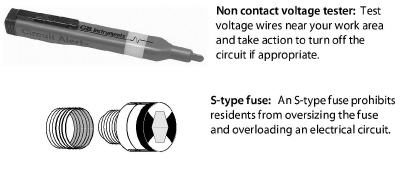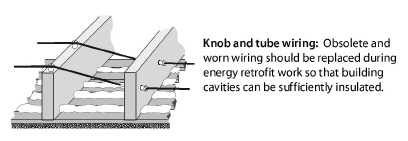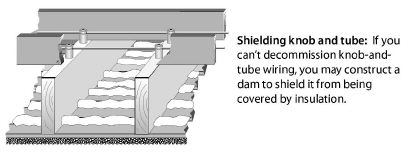
Electrical fires and shocks are common and serious safety problems. Electrical safety is a basic housing need, requiring attention during home weatherization and repair.
Observe the following specifications for electrical safety in weatherizing existing homes.

ü Whenever working around wiring, use a non-contact voltage tester to determine whether circuits are live. Turn circuits off at circuit breakers as appropriate.
ü Inspect wiring, fuses, and circuit breakers to verify that wiring isn’t overloaded. Install S-type fuses where appropriate to prevent circuit overloading. Maximum ampacity for 14-gauge wire is 15 amps and for 12-gauge wire is 20 amps.
ü Confirm that all wire splices are enclosed in electrical junction boxes. If you plan to cover a junction box with insulation, attach a flag to mark its location.
ü Don’t allow metal insulation shields to contact wiring.
ü Verify that the electrical system is grounded to either a ground rod or to a water pipe with an uninterrupted electrical connection to the ground.
ü Install S-type fuses where appropriate to prevent occupants from installing oversized fuses.
ü Perform a voltage-drop test to evaluate the size and condition of hidden wiring on older homes if appropriate.
ü Whenever you doubt the integrity of a home’s electrical system, use a generator to power insulation blowers and other large power tools.
Decommission knob-and-tube wiring before or during weatherization if possible. Try to convince your clients or their landlords to replace knob-and-tube wiring with their own funds.

Use a non-contact voltage tester to determine whether the knob-and-tube wiring is live. If you’re unsure about whether the wiring is still live, schedule an inspection by a qualified and experienced electrician.
If the knob-and-tube wiring in an attic is live, ask an electrician and/or an electrical inspector to determine whether the attic wiring can be decommissioned and replaced with non-metallic sheathed electrical cable. Depending on the situation, the electrician may choose one of these two options.
1. Terminate the existing attic knob-and-tube wiring, and connect the new NM circuit directly to the main service box.
2. Install a flagged junction box in the attic to connect the knob-and-tube riser to new NM cable in the attic.
Consider installing a hard-wired CO/smoke detector in a common area near the bedrooms on the new circuit.
You may install attic insulation up to the bottom of knob-and-tube wiring, but never cover knob-and-tube wiring with insulation that covers the wires.

ü Construct structural dam to maintain a 3-inch clearance between attic insulation and knob-and-tube wiring. Do not cover the knob-and-tube wiring.
ü Flag the shielding structure before insulating over it to mark it for future access or removal.